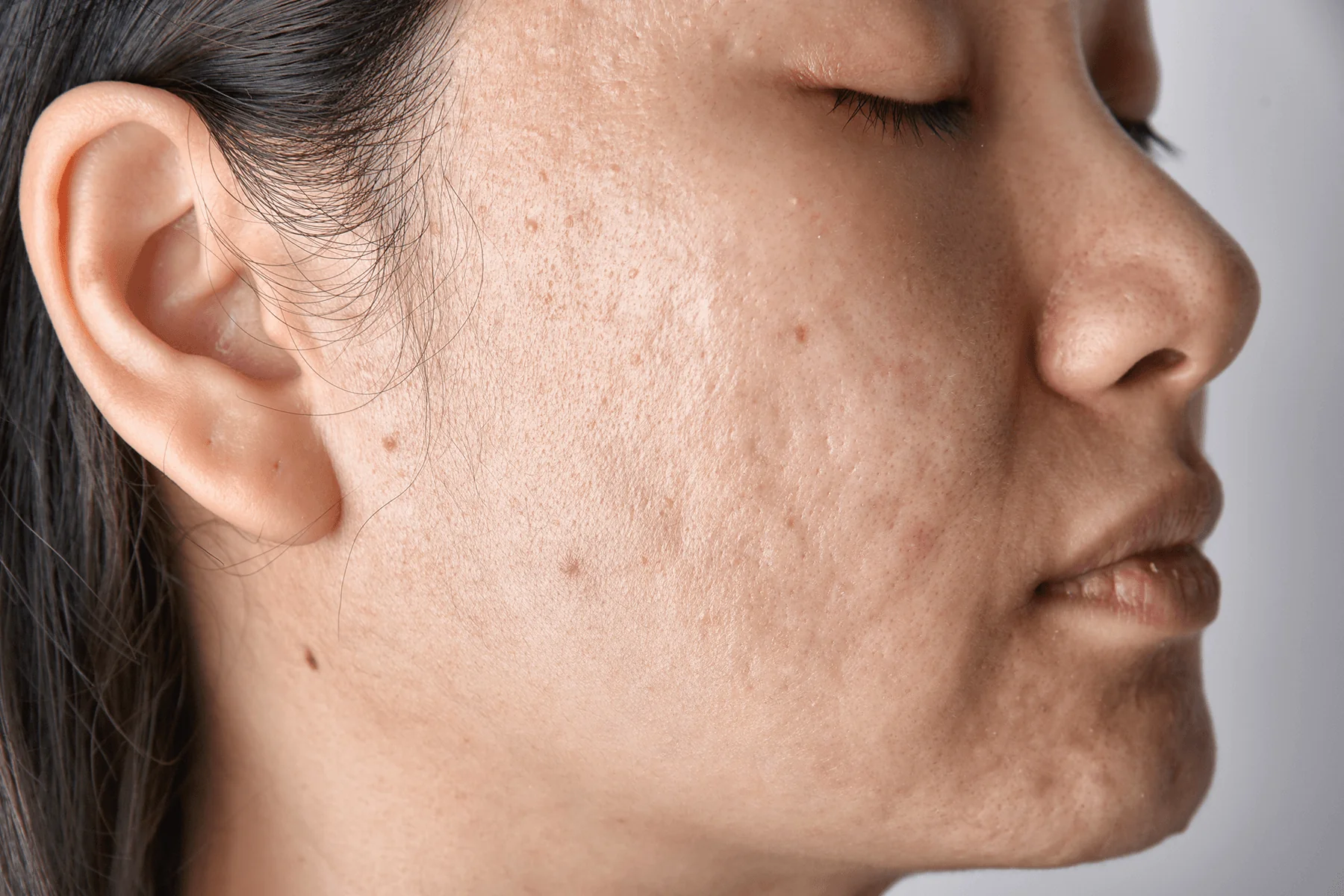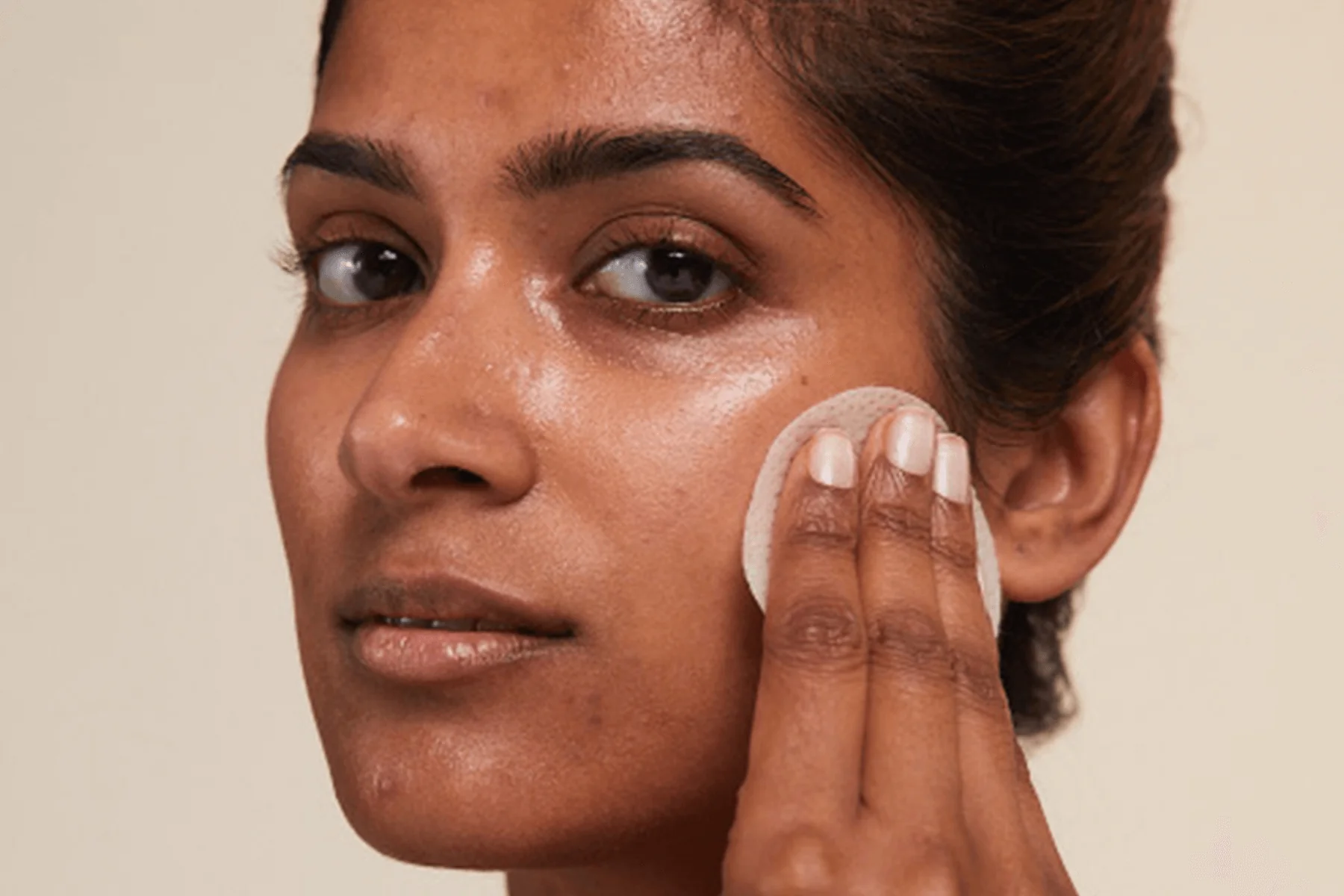The+Source
As if a raging case of acne itself wasn’t enough, it can also leave behind an unwelcome reminder, long after your outbreak has become a distant memory. We’re talking about scarring. Whether major or mild, these lasting marks add insult to injury.
Types of acne scars
There are four main kinds of acne scars, listed below, that fall into two categories: atrophic (brought on by a loss of tissue and usually the result of severe cystic acne) and hypertrophic (caused by an abundance of tissue). Once you identify the type you have, you can formulate a plan of attack.

The four scar types are:
- Ice pick scars
- Boxcar scars
- Rolling scars
- Hypertrophic scars
Ice Pick Acne Scars
How do ice pick scars form?
These narrow, deep atrophic scars look like the result of a puncture wound (hence the name) and are most common on cheeks. They go all the way down into the dermis and are the aftereffect of infected, cystic acne making its way to the skin’s surface. On that journey, skin tissue is destroyed, and a cylindrical, column-like depression remains.
How are ice pick scars treated?
Scar treatment for this type of acne scar requires a trip to the dermatologist’s office. Due to their depth, ice pick scars can’t be resolved with a topical cream (prescription or over-the-counter). They’re even too deep for laser resurfacing or fillers to have a meaningful impact (although those remedies work for other kinds of scars). Instead, your doctor will likely recommend punch incision or punch grafting. In both instances, the scar is cut out of the skin, then the area is closed—either with sutures or glue (punch incision) or skin graft (punch grafting). While both remedies also leave a scar, it’s much less noticeable than the ice pick version it’s replacing. Plus, the fix is a one-and-done; you won’t need to return for a second session.
Boxcar Acne Scars
How do boxcar scars form?
Boxcar scars are another type of atrophic acne scar but are wider than the ice pick variety and deeper. Due to their round or oval shape, boxcar scars give the skin a pitted appearance. They develop when an inflamed blemish destroys collagen in the skin. Lacking underlying support, the skin sinks in that area – kind of like an old mattress with busted springs. Although boxcar scars can develop anywhere, you’re most likely to see them on the lower cheeks and jawline.
How are boxcar scars treated?
For boxcar scars, the goal of scar treatment is to raise the depressed section up to the level of the surrounding skin. Injectable fillers can be the best bet here. While they need to be repeated every six months to two years, hyaluronic acid fillers are a relatively fast and simple procedure that produces noticeable improvement.
Another option is laser resurfacing (either ablative or non-ablative) to smooth out the pitted areas. Smoothbeam is a non-ablative diode laser often used to reduce active acne, but it can also induce collagen production to plump up indentations. Depending on the depth of your scarring, it may take multiple laser treatments, spaced weeks apart, for you to achieve your end goal.
Rolling Acne Scars
How do rolling scars form?
You’ll know you have rolling scars if your skin indentations are wide, shallow, and wavy. Also a member of the atrophic family, rolling scars develop when fibrous bands form between the epidermis and hypodermis (the subcutaneous skin layer located beneath the dermis), pulling down the skin’s surface (not unlike the way a cellulite dimple is created). As a result, skin looks generally uneven.
How are rolling scars treated?
There are a variety of scar treatments your dermatologist may employ in this situation. Subcision, in which your doctor uses a needle to cut the band of fibers tugging down the epidermis, can help the skin appear smoother. Microneedling, which builds collagen over a series of treatments and months, can be particularly helpful if the scarring is widespread. Laser resurfacing can also help even out skin, assuming the indentations aren’t too deep, as can in-office chemical peels (although these are only effective on shallow scars).
Hypertrophic Acne Scars
How do hypertrophic scars form?
The opposite of the three types of scars outlined above, hypertrophic scars are raised scars that rise above the surrounding skin and are generated from an overproduction of collagen. While they can crop up anywhere on the body, hypertrophic scars are most often spotted on the back, chest, and shoulders.
How are hypertrophic scars treated?
This procedure involves injections (typically of a corticosteroid, like cortisone, although other medicines are sometimes used) into the scar tissue to help reduce its mass. You’ll need to commit to a series of these, often spaced over several weeks, to attain optimal results. In certain cases, in which stronger treatment is required, a dermatologist will surgically remove the raised scar first, then follow with a series of injections for a few months.
When scars are both raised and red, a pulsed dye laser (such as the Vbeam) is an effective tool to remedy the situation. In lighter skin tones, Intense Pulsed Light (IPL) sessions can be another option.
The Wild Card: Post-Inflammatory Hyperpigmentation
This is actually not a type of acne scar. However, post-inflammatory hyperpigmentation (aka a dark or discolored patch of skin) can appear once an acne breakout goes away, which makes it seem kinda, sorta like a scar. It’s most common in people with darker skin tones or those who pick at, squeeze, or otherwise fuss with a breakout (skincare PSA: Stop that!). As long as you slather on sunscreen every day (a minimum of SPF 30), post-inflammatory hyperpigmentation usually resolves on its own over time. However, skin-brightening ingredients, like vitamin C or hydroxy acids like BHA and AHA, can help speed along the process. Adding retinol to your routine will also assist in reducing the appearance of dark spots, plus it can boost collagen production—handy for any unevenness your genuine acne scar may have left lingering.
Discover Dr. Dennis Gross Skincare for All Your Skincare Needs
For more skincare tips from the experts at Dr. Dennis Gross, check out our blog’s newest content today. Shop the collection of Dr. Dennis Gross bestselling skincare backed by dermatologists.



